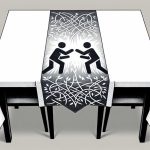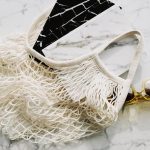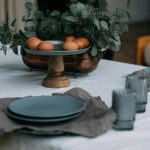Imagine the satisfaction of creating something beautiful and functional with your own hands—DIY fabric projects offer just that. As a beginner, you might feel a bit overwhelmed, but starting with the right tools and basic techniques can set you on the right path. From selecting the perfect fabric to mastering simple stitches, each step is a building block towards more complex projects. Whether you're aiming to craft a simple tote bag or a decorative table runner, there's a method to the madness. Ready to reveal the secrets of fabric crafting? Let's get started.
Table of Contents
Key Takeaways
- Choose simple designs like tote bags and pillowcases to build confidence and skills.
- Use clear plastic bins for organizing fabric to maintain order and accessibility.
- Learn basic stitches such as the running stitch, backstitch, and whip stitch for versatility in projects.
- Pre-wash fabric with mild detergent and cold water to ensure it's clean and pre-shrunk.
- Utilize sharp fabric scissors or a rotary cutter and cutting mat for accurate and clean cuts.
Essential Tools
To get started with your DIY fabric projects, you'll need a few essential tools to make the process smooth and enjoyable.
First and foremost, a reliable sewing machine is indispensable. It's the backbone of your sewing endeavors, allowing you to stitch with precision and efficiency. Investing in a good quality sewing machine will save you time and frustration in the long run, providing you with consistent, professional outcomes.
Next, proper fabric storage is vital. Keeping your fabrics organized and easily accessible can make a world of difference. Consider using clear plastic bins or fabric organizers to categorize your materials by type, color, or project. This not only saves space but also guarantees your fabrics remain in pristine condition, free from dust and wrinkles.
Don't forget about the basics: a sharp pair of fabric scissors, a rotary cutter, and a self-healing cutting mat. These tools allow you to cut your materials accurately and with ease. Additionally, having a good set of pins, needles, and thread in various colors will prepare you for any sewing project.
Choosing Fabrics
Now that you've got your tools ready, let's explore how to choose the right fabrics for your projects. Start by considering the fabric textures that best suit your project. Smooth fabrics like cotton or silk are excellent for garments, while rougher textures like burlap or canvas work well for crafts and home decoration.
Next, think about your color palettes. Select colors that complement each other and align with the purpose of your project. For example, vibrant colors might be perfect for a child's playroom, while muted tones could be better for a sophisticated living area.
Understanding pattern repeats is essential. Pattern repeats refer to the recurring design elements on the fabric. Measure your fabric carefully to make sure the patterns align correctly, especially if you're making items like curtains or tablecloths where symmetry matters.
Fabric weight is another important factor. Heavier fabrics like denim or upholstery material are ideal for durable, long-lasting projects, whereas lighter fabrics such as chiffon or voile are perfect for delicate, airy items.
Basic Sewing Stitches
Let's explore the vital sewing stitches you'll need to master for any DIY fabric project. First up is the running stitch, one of the most common stitches. It's perfect for basting or temporary seams. Keep your stitches even, as uneven ones can cause puckering—a common beginner mistake.
Next, practice the backstitch. It's stronger and ideal for permanent seams. Guarantee each stitch overlaps slightly with the previous one for durability.
Now, let's move on to the whip stitch, which is great for hemming or closing seams. Angle your needle consistently to avoid uneven edges.
For a clean finish, try the ladder stitch, especially useful in advanced techniques like invisible seams.
An important stitching tip: always knot your thread securely to prevent unraveling. Also, keep an eye on your thread tension—too tight, and the fabric puckers; too loose, and the stitches gape.
Avoid these beginner mistakes: rushing through stitches or not practicing enough. Mastery comes with repetition. Familiarize yourself with these common stitches, and you'll build a solid foundation.
As you gain confidence, you'll be ready to tackle more advanced techniques with precision and finesse.
Understanding Patterns
When starting with patterns, choose simple designs to build your confidence.
Make sure you thoroughly read the pattern instructions before cutting any fabric.
This will help you understand the steps and avoid any mistakes.
Choosing Simple Designs
Understanding patterns is key to choosing simple designs that guarantee your DIY fabric projects are both manageable and successful. Patterns serve as the blueprint for your creations, guiding you through each step. As a beginner, start with straightforward patterns to build your confidence and avoid common beginner mistakes like complex fabric selection.
Choosing simple designs doesn't mean your projects can't be unique. Look for patterns that allow for creative embellishments, transforming basic designs into something special. For instance, a plain tote bag can be jazzed up with handmade pockets or decorative stitching. These small touches make even beginner projects feel personalized and professional.
When selecting a pattern, pay attention to the fabric recommendations. It's easy to make beginner mistakes by picking fabrics that are too stretchy or difficult to sew. Stick to stable fabrics like cotton or linen, which are easier to manage and forgiving for newbies. Here's a quick guide to help you make informed decisions:
| Pattern Type | Recommended Fabric | Difficulty Level |
|---|---|---|
| Simple Tote Bag | Cotton, Canvas | Beginner |
| Basic Pillow Cover | Linen, Cotton | Beginner |
| Straight Skirt | Cotton, Linen Blend | Beginner |
Reading Pattern Instructions
Mastering the skill of reading pattern instructions is necessary for successfully completing your DIY fabric projects. Understanding these instructions will optimize your sewing process and help you avoid common mistakes.
Begin by familiarizing yourself with the various pattern symbols, as these will guide you through different sewing techniques and steps.
When you open your pattern, you'll see a wealth of information. Pay close attention to:
- Pattern symbols: These include notches, darts, and grain lines. Knowing these will help you align pieces accurately.
- Pattern size: Be sure you select the correct size to avoid fitting issues. Sizes can vary between brands, so always check the measurements.
- Alterations: Patterns often include lines for shortening or lengthening. These are essential if you need to make adjustments for a perfect fit.
- Troubleshooting tips: Many patterns offer advice for common problems. Refer to these if you encounter any issues.
Simple Tote Bag
Creating a simple tote bag is a fantastic way to practice your sewing skills.
Start by selecting the appropriate fabric material.
Then, focus on cutting and measuring it accurately.
Choosing Fabric Material
When selecting fabric material for a simple tote bag, ponder both durability and aesthetics to ensure your bag is functional and stylish. The appropriate fabric will guarantee your tote withstands wear and tear while also reflecting your personal taste.
Start by evaluating fabric durability and color choices. Canvas and denim are excellent sturdy options that can handle daily use. Lighter fabrics like cotton may be less resilient but offer a wide range of colors and prints.
Next, contemplate your texture preferences and desired print patterns. Do you prefer a smooth finish or a more textured feel? Fabrics like linen offer a natural texture, while twill provides a more structured look. Print patterns can significantly alter the bag's appearance, from bold geometrics to delicate florals.
Here are some fabric options to explore:
- Canvas: Highly durable, great for everyday use, available in various colors.
- Denim: Sturdy, trendy, versatile with different washes.
- Linen: Offers a natural texture, perfect for a casual, relaxed look.
- Cotton: Light, easy to sew, endless variety in colors and prints.
Selecting the appropriate fabric material is essential in creating a tote bag that not only lasts but also showcases your unique style.
Cutting and Measuring
Measuring and cutting your fabric accurately is important to make sure your tote bag comes together seamlessly. First, choose a sturdy fabric like canvas or denim. Lay it flat on a cutting mat to guarantee stability. Use a clear ruler to measure your fabric, ensuring precise measuring. For a standard tote bag, measure two rectangles, each 16 inches wide by 18 inches long.
Mark your measurements using tailor's chalk or a fabric marker. It's vital to double-check your measurements before you cut. This step avoids any costly mistakes and guarantees your fabric pieces align perfectly.
When it comes to fabric cutting, sharp scissors are your best friend. Use long, smooth cutting techniques to avoid jagged edges. Alternatively, you can use a rotary cutter for even more precise cuts. Place a cutting mat beneath to protect your work surface and to keep your cuts straight.
Here are some measuring tips: always measure twice to confirm accuracy and use weights to keep your fabric from shifting. This attention to detail guarantees your tote bag pieces will match up perfectly when you start sewing, making the assembly process much easier.
Sewing Techniques Explained
To start sewing your simple tote bag, thread your sewing machine with a matching color and set it to a straight stitch. This beginner fabric project is a great way to practice both hand sewing basics and machine sewing techniques.
Begin by sewing the side seams of your tote. Align the edges of your fabric pieces, and sew along the sides and bottom, leaving the top open.
Next, create boxed corners to give your tote bag structure. Pinch each bottom corner, aligning the side seam with the bottom seam to form a triangle, and sew across the point. This step is essential for mastering more advanced sewing projects later on.
Here are a few key steps to keep in mind:
- Reinforce stitches: Sew back and forth at the start and end of each seam to secure the stitches.
- Press seams: Use an iron to press the seams open for a cleaner finish.
- Add handles: Attach pre-made handles or sew your own from fabric strips.
- Finish the top edge: Fold the top edge down twice, press, and sew to create a neat hem.
Cozy Pillowcases
Transform your bedroom into a haven of comfort by creating your own cozy pillowcases. Start by selecting a soft, high-quality fabric that complements your bedroom decor. Once you've chosen your fabric, consider adding decorative embroidery to elevate the design. Embroidery can include unique patterns that reflect your personal style and bring a touch of elegance to your space.
Next, think about incorporating custom monograms. These personalized touches make your pillowcases truly one-of-a-kind. Use colorful prints to add vibrancy and character to your room, ensuring each pillowcase stands out. You can mix and match different fabrics to create a diverse yet cohesive look.
To sew your pillowcases, cut the fabric to the size of your pillows, allowing for seam allowances. Fold the fabric, right sides together, and stitch around the edges, leaving one end open.
After sewing, turn the pillowcase right-side out and press it for a polished finish. Don't forget to add closures like zippers or buttons for a neat, professional look.
Fabric Bookmarks
Creating fabric bookmarks is a fun and practical project that lets you express your creativity.
Start by choosing the right fabric types.
Then use simple sewing techniques to bring your bookmark to life.
Don't forget to add personal touches to make it uniquely yours.
Choosing Fabric Types
When selecting fabric for your bookmarks, consider both durability and aesthetic appeal to make sure they're both functional and beautiful. The right fabric types will guarantee your bookmarks last through many reading sessions and look stunning peeking out from the pages of your favorite book.
Focus on two main factors: fabric weights and color coordination.
Fabric weights are essential. Lightweight fabrics like cotton and linen are great for beginners, offering ease of handling and flexibility. Heavier fabrics such as denim or canvas provide extra durability, making sure your bookmarks don't fray or wear out quickly.
Beyond durability, color coordination plays a critical role. Coordinating colors and patterns can turn a simple bookmark into a small piece of art. Here are a few fabric ideas to get you started:
- Cotton: Available in countless patterns and colors, easy to work with.
- Linen: Offers a smooth texture and a touch of elegance.
- Denim: Perfect for a rustic, sturdy bookmark.
- Canvas: Highly durable, great for a more substantial feel.
Selecting the right fabric type is the first step in creating a bookmark that isn't only practical but also a joy to use and behold.
Simple Sewing Techniques
Now that you've selected the perfect fabric, let's explore some simple sewing techniques to create your bookmarks.
Start by cutting your fabric into rectangular pieces, typically 2 inches by 6 inches. Precision in cutting guarantees your bookmarks have clean edges and uniformity. Once cut, use fabric dyeing to add a base color if your fabric is plain. Just follow the dye instructions for vibrant, long-lasting hues.
Next, consider fabric painting for intricate designs. Use fabric paints and stencils to create patterns or freehand your own designs. This step personalizes your bookmarks and enhances their visual appeal.
For those seeking more detailed work, pattern making can be an excellent choice. Draw your desired patterns on paper first, then transfer them onto the fabric.
To add texture and a touch of elegance, incorporate embroidery. Use simple stitches like backstitch or running stitch to outline shapes or create motifs. This not only improves the aesthetic but also strengthens the fabric.
Adding Personal Touches
Adding personal touches to your fabric bookmarks transforms them from simple crafts into unique, meaningful keepsakes. By incorporating custom embroidery and fabric painting, you can elevate your bookmarks and showcase your creativity and skill. Start by selecting a high-quality fabric and envisioning a design that reflects your personality or interests.
Consider these ideas to add flair to your bookmarks:
- Custom Embroidery: Stitch your initials, a favorite quote, or intricate patterns to make each bookmark a one-of-a-kind piece. Use contrasting thread colors to create striking designs.
- Fabric Painting: Paint small, detailed illustrations or abstract patterns directly onto the fabric. Fabric paints come in a variety of finishes, so experiment with metallic or glitter options for added sparkle.
- Beaded Edges: Sew beads along the edges of your bookmarks for a tactile and visual enhancement. Choose beads that complement your embroidery and painting.
- Appliqué: Attach small fabric shapes or patches to your bookmark. This adds dimension and can be a great way to use up fabric scraps.
Easy Table Runners
Creating easy table runners is a fantastic way to add a personal touch to your dining space without much hassle. You can start by selecting fabrics that match your seasonal decorations or holiday themes, making your table the centerpiece of any gathering.
Imagine the joy of gifting a beautifully tailored table runner as a holiday gift; it's both thoughtful and functional.
For those who seek to elevate their projects, consider incorporating custom embroidery. Adding hand-stitched details can transform a simple runner into a masterpiece. Use contrasting thread colors to make your designs pop, or opt for subtle tones that blend seamlessly with your fabric.
Embroidery allows you to personalize each piece, whether you're stitching monograms, intricate patterns, or festive motifs.
To create your table runner, measure the desired length and width, then cut your fabric accordingly. Hem the edges to prevent fraying, and consider adding a backing fabric for extra durability.
If you're feeling adventurous, embellish the runner with lace, ribbons, or other trims. With these simple steps, you'll have a stunning table runner that reflects your style and craftsmanship, making every meal a special occasion.
No-Sew Projects
Plunge into no-sew projects that let you craft beautiful fabric creations without ever threading a needle. Embrace the freedom and simplicity that comes with using fabric glue alternatives and heat bond techniques. Whether you're a seasoned crafter or new to DIY fabric crafts, these methods offer endless possibilities to transform fabric into stunning pieces.
Here are some inspiring no-sew projects to get you started:
- Tote Bags: Create a stylish tote bag with just fabric, fabric glue, and a bit of creativity. Cut, fold, and glue the edges for a sturdy, fashionable accessory.
- Pillows: Design custom pillows by cutting fabric to size and using heat bond techniques to seal the edges. No sewing machine needed!
- Curtains: Craft elegant curtains by measuring your window, cutting fabric, and using fabric glue alternatives to hem the edges. Attach curtain rings and hang.
- Fabric Wall Art: Turn fabric scraps into wall art by stretching them over frames and securing with glue. Mix patterns and textures for a unique look.
Dive into these no-sew fabric projects and watch your crafting skills soar. Mastering these techniques will empower you to create without the constraints of traditional sewing.
Tips and Tricks
Mastering a few tips and tricks can elevate your DIY fabric projects from good to spectacular. Start with fabric organization and storage. Invest in clear, labeled bins to keep your materials sorted by type or color. This not only saves you time when searching for the right fabric but also protects your pieces from dust and damage.
Hanging fabric is another efficient method; use a garment rack to store larger pieces without creasing them.
Next, focus on fabric care and maintenance. Always pre-wash your fabric to avoid shrinkage issues later on. Use a mild detergent and cold water to preserve colors and prevent fading. After washing, iron your fabric to remove any wrinkles, ensuring a smooth and professional finish. Store your ironed fabric flat or rolled, rather than folded, to avoid creating permanent creases.
When cutting fabric, use sharp scissors or a rotary cutter for clean edges. Dull tools can fray your fabric and make precise cuts difficult. Additionally, maintain a clean workspace to keep your materials in top condition.
Frequently Asked Questions
How Do I Store Leftover Fabric Scraps Effectively?
Start by sorting your fabric scraps by size, color, and material. Use labeled bins or clear jars for organized storage. Turn your scrap organization into creative ideas by planning fabric scrap mini projects to keep things exciting.
Can I Use Fabric Glue Instead of Sewing for All Projects?
You can't use fabric glue for all projects due to its limitations. For more durable results, explore fabric glue alternatives like hand sewing or machine sewing techniques. Mastering these skills will elevate the quality of your work.
What Are Some Eco-Friendly Fabric Options for DIY Projects?
You've got some great eco-friendly choices! Consider upcycled options like repurposed clothing or sustainable materials such as organic cotton, hemp, and bamboo. These choices not only reduce waste but also guarantee your projects are environmentally responsible.
How Do I Prevent My Fabric From Fraying?
To prevent your fabric from fraying, use fabric edge finishes like zigzag stitches or pinking shears. Fray prevention techniques also include applying seam sealant or using bias tape. Master these methods to achieve professional, durable results.
What Are Some Common Mistakes Beginners Make in Fabric Projects?
Imagine cutting a beautiful fabric for a dress, but it doesn't fit right. Choosing wrong materials and ignoring seam allowances are common mistakes that can ruin your project. Always double-check your fabric choice and measure seam allowances precisely.
- Tetron Fabric for Marine Applications: Durability and Use Cases - June 18, 2025
- Tetron Fabric for Outdoor Furniture: Weather Resistance and Care - June 18, 2025
- Tetron Fabric for Wall Coverings: Style and Application Tips - June 18, 2025







